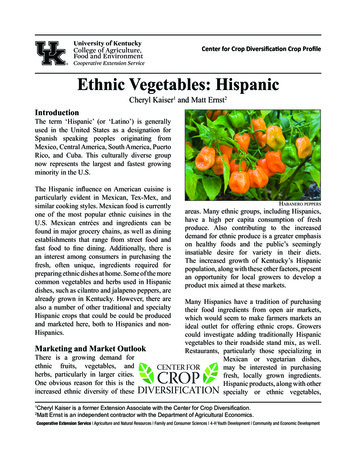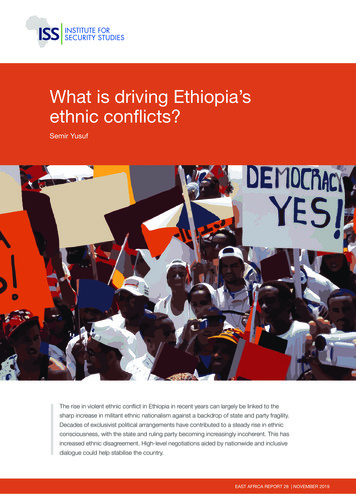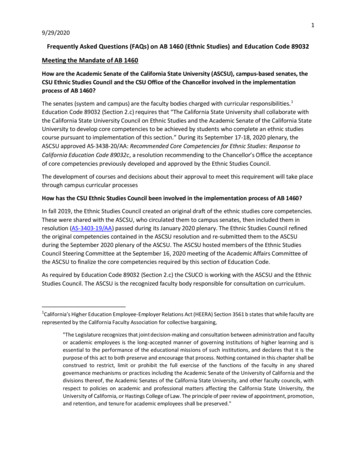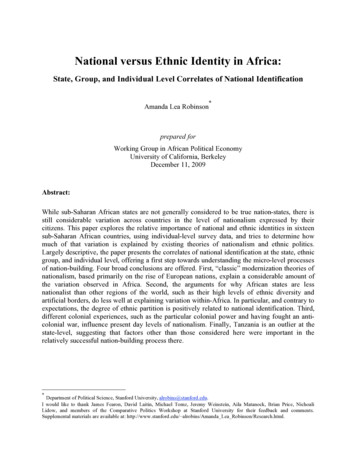Mobilizing Ethnic Competition - Arts & Sciences Pages
Theor SocDOI 10.1007/s11186-012-9178-4Mobilizing ethnic competitionDavid Cunningham# Springer Science Business Media B.V. 2012Abstract Ethnic competition theory provides a powerful explanation for ethnicconflict, by demonstrating how variation in ethnic mobilization relates to intergroupstruggles over scarce resources. However, the tendency to capture such relationshipsat the aggregate level, through macro-level proxies of intergroup competition, offerslittle insight into the processes through which ethnic grievances mobilize into contentious action. This article integrates insights from the social movements literature toaddress how competitive contexts crystallize into broader conflicts. Drawing on datafrom the civil rights-era Ku Klux Klan—perhaps the quintessential case of contentious ethnic organization in the United States—the analysis focuses on the ways inwhich meso-level arrangements mediate the relationship between overarching competitive contexts and ethnic conflict. Results of a paired comparative analysis of KKKmobilization in Greensboro and Charlotte demonstrate that social and spatial relationswithin each city shaped the contours of perceived competition and subsequent ethnicorganization in ways that were not always predictable through observation of conventional proxies of competition.Keywords Social movements . Intergroup conflict . Comparative-historicalmethods . Threat . Civil rights . Ku Klux KlanEthnic competition theory provides a powerful explanation for intergroup conflict,ranging from riots, to church burnings, to voting behavior, to hate group mobilization.Rooting contention in struggles over resources, the theory postulates that ethnicsolidarities intensify when members of multiple groups occupy similar positions—most often associated with overlapping labor market niches—and vie for scarcerewards. The basis for conflict lies in the threat posed by competing groups, forwhom ethnic identities take on enhanced salience in competitive contexts.D. Cunningham (*)Department of Sociology, Brandeis University, MS 071, Waltham, MA 02454-9110, USAe-mail: dcunning@brandeis.edu
Theor SocEthnic competition explanations are by nature contextual, as they posit thatcontention among individuals and groups is in fact shaped by environments that lendthemselves to perceived or actual contests over available resources. While relatedmodels are thus concerned with how competitive settings shape perceptions andattributions of threat and ultimately spur group conflict, conventional analyses havetended to operate at the aggregate level, demonstrating how variation in ethnicmobilization is related to overall levels of ethnic heterogeneity or labor marketoverlap in nations, states, or municipalities (see, e.g., Brown and Boswell 1997;Mousseau 2001; Myers 1997; Olzak 1989; Van Dyke and Soule 2002; Wilkes andOkamoto 2002). Such relationships confirm the power of environments marked bycompetition for scarce resources, but they are limited in their ability to interrogate theways in which broad contexts produce group conflict.Further, while competitive dynamics are most striking when they result in sustained mobilization and protracted conflict (Olzak 1992), ethnic competition explanations offer little insight into the processes through which ethnic grievances translateinto mobilized contention, a longstanding concern of social movement theorists(McAdam 1999; Tarrow 1998). As a result, competition models are unable to teaseout the direct versus indirect effects of competition—i.e., whether associated conflictsare initiated by individuals who are themselves in direct competition for resources, oralternately whether they emerge in a more diffuse manner in areas marked by ageneralized competitive climate. They also fail to explain how the presence of ethnicconflict is shaped by the social and spatial organization of associations, whichmediate the coalescence of grievances within communities and thus serve as crucialmobilization venues (Cunningham and Phillips 2007). In this sense, the emphasis onmeso-level associational settings in the mediated competition approach advancedhere does not represent a call to be still more precise in one’s choice of contextualunit, but rather a theoretically-distinct effort to examine how social settings affectperceptions of inter-group competition. Such perceptions likely have much to do withthe presence of out-group members, but also with how those alters relate socially,spatially, and culturally to available resources and mobility structures.This article thus places attention squarely on how competitive contexts, throughthe influence they exert on individuals and groups, crystallize into broader conflicts. Ibegin with a critical review of ethnic competition theory and show how our understanding of the dynamics of ethnic competition has been limited by a pronouncedinattention to the ways in which contention emerges within broad competitiveenvironments. Drawing on data from the civil rights-era Ku Klux Klan (perhaps thequintessential case of contentious ethnic organization in the United States1)—Iengage with existing research that explains how social location shapes the likelihood1Indeed, in this particular case “ethnic competition” and “ethnic conflict” might reasonably be seen aseuphemisms for vehement racism. The KKK was (and continues to be) a white supremacist organization,and its resistance to civil rights advances during the 1960s was undergirded by a clear sense that AfricanAmericans’ racial status precluded legitimate co-existence and competition with whites in economic,political, and social spheres. In the Jim Crow South, such views were widely shared within the whitepopulation, though the Klan’s willingness to defend militantly its constituents against the “threat” posed bycivil rights reforms was distinctively extreme. In this sense, “competition” becomes a primary mechanismfor the activation of organized racism.
Theor Socof particular individuals mobilizing in the presence of ethnic contention. Then,building on related insights focused on relational contexts for mobilization, I showhow differences in the associational makeup of two demographically-similar communities in the Carolina Piedmont—Greensboro and Charlotte—explain significantvariation in the KKK’s ability to organize in each city. Through a comparativeanalysis that emphasizes economic, educational, and residential patterns within eachcity, I demonstrate how meso-level associational structures mediate the presence ofcompetition and the subsequent emergence of KKK mobilization, explaining outcomes not always predictable through examination of conventional proxies ofcompetition.Theories of ethnic competitionEthnic competition theory builds on Barth’s (1969) emphasis on the sociallyconstructed boundaries through which ethnic groups ascribe difference.Competition, stemming from overlap in the economic or political activities ofmultiple ethnic groups,2 becomes a key mechanism through which particular boundaries are reinforced. This enhanced salience of ethnic divisions, in turn, can contributeto the emergence of ethnic conflict (Hannan 1979; Olzak 1992). Both ethnicboundary-formation and emergent conflicts are generally suppressed when groupsinhabit separate, spatially-distant, or complementary niches in labor markets andpolitical systems. But when competing groups occupy similar positions, thus exhibiting considerable niche overlap, ethnic solidarities intensify and contribute to increased competition-based conflict (Barth 1969; Soule and Van Dyke 1999).Competition conventionally is conceptualized at the macro-level, through indicesof county/state/national conditions hypothesized to breed competition among ethnicsub-groups. The presence of out-group members, for instance, or the scarcity ofeconomic or political resources within municipal units, commonly serve as macroproxies of inter-group competition (Brown and Boswell 1997; Schneider 2008; Souleand Van Dyke 1999). Other research more precisely focuses on how threats emerge inhighly-competitive economic or political niches, defined by inter-ethnic overlap inspecific labor market sectors or increasing political representation by ethnic minorities (Cunningham and Phillips 2007; Medrano 1994; Olzak 1989, 1992; Van Dykeand Soule 2002).This contextual logic holds even for studies that employ narrower units of analysis.For instance, Bergeson and Herman (1998, p. 39) argue strongly for defining units bytheir degree of salience to relevant groups. Their investigation of the 1992 LosAngeles riots thus employs census tract data, rather than more typical city-levelaggregations, to match previous research showing that “people tend to engage in riotactivity close to where they live.” Tolsma et al. (2008), reacting to inconsistencies inthe competition literature, note that outcomes are conditioned by “the unit of2Note that, while ethnic identities have been seen as primary determinants of group conflict (especially inlabor settings), the general competition logic outlined here can extend to other bases for collective identity:gender, sexuality, nationality, and so on.
Theor Socmeasurement of the locale” and focus on the neighborhood level, where local politicaldecisions are forged and residents’ social networks are most dense. Still, these moreprecise analyses maintain the usual logic of relating competition to the overallcomposition of the unit in question, and do not address how the broad makeup ofparticular locales is reflected in social life, through the organization of associations—i.e., schools, businesses, religious centers, civic organizations, and so on. Similarly,efforts to link individual locations within these settings to propensities to engage inethnic conflict (Aguirre et al. 1989; Coenders and Scheepers 2008; Scheepers et al.2002; Tolsma et al. 2008) generally focus on rough proxies of competition—such aswhether persons hold a “low social status” or reside in an urban area (Schneider 2008,p. 55)—rather than capture precisely the degree to which individuals overlap economically, politically, and socially with ethnic others.Regardless of the unit of analysis employed, there is broad implicit agreement thatcontextual conditions translate into ethnic conflict or exclusion through their impacton individual grievances, i.e., people’s perceptions that they are threatened bymembers of competing ethnic groups. While the relationship between contexts andgrievances is often assumed rather than demonstrated, it is clear that competitivecontexts do not translate into ethnic grievances in a straightforward and invariantmanner. Belanger and Pinard (1991) have found that active contention emerges insettings conducive to inter-group competition, but only when associated conditionsare perceived as unfair. Such perceptions, they observe, do not uniformly follow fromthe presence of competition for finite resources. Soule and Van Dyke (1999) likewisenote the possibility of mismatch between “objective” levels of competition andindividuals’ sense of perceived threats. Scheepers et al. (2002), employing a combination of demographic and individual survey data, show that socioeconomic conditions and residents’ perceptions interact to increase the likelihood of individuals’support of ethnic exclusionism. Bobo and Hutchings (1996) focus on the processesthat underlie such interactions, by extending Blumer’s theory of group position tohighlight the historically, materially, and socially contingent manner in which“threats” come to be perceived and encoded as inter-group prejudice.Accounting for mechanisms that mediate relationships among structural contexts,individual perceptions, and contentious outcomes seems especially important whenconflicts involve sustained mobilization. As these settings require more from aggrieved individuals than an expression of anti-ethnic attitudes or electoral support forin-group candidates, they should more durably reflect competitive settings. The factthat grievances are marshaled toward collective ends also points to processes welldocumented in the social movements literature, involving the mobilization of resources required for organizational coordination and the “frame alignment processes” thatchannel grievances toward movement action (Edwards and McCarthy 2004;McAdam 1999; Benford and Snow 2000; Okamoto 2003; Tarrow 1998).While the majority of existing applications of ethnic competition theory focus onexclusionary attitudes or discrete actions, Olzak et al. (1994), Cunningham andPhillips (2007), and Van Dyke and Soule (2002) deal with these sorts of durablemovement organizations and protest campaigns. The latter two of these studiesexplicitly seek to integrate competition and social movement approaches to ethniccontention. For Van Dyke and Soule, the key insight is for social movement theorists,who frequently discount or neglect entirely the mobilizing power of grievances.
Theor Soc“Theories of social movement emergence,” they assert, “should include structuralsocial change and the threat it engenders as important mobilizing conditions”(p. 513). Cunningham and Phillips seek to demonstrate the converse, applyinginsights related to social movement diffusion to threat-based ethnic contention. Inparticular, they show that the diffusion of “reactive mobilization,” strongest incounties that are most closely tied in a social and economic sense, point to the factthat threats are necessarily constructed and mobilized through existing social channels. In each case, however, these analyses adopt the established logic, focused onhow mobilization is patterned across large municipal units (SMSAs and states), andthus are not concerned with the mobilization processes that follow from the imposition of competition-induced threats.To interrogate these mediating processes, I examine a case of sustained ethnicmobilization, associated with the rise of the Ku Klux Klan in North Carolina between1964 and 1966. Specifically, I examine why the KKK had uneven success mobilizingworkers across the North Carolina Piedmont, a region marked by a moderate, andrelatively homogeneous, degree of racial competition in the labor market. Through acomparative focus on Greensboro, a Klan hotbed, and Charlotte, where the KKK waslargely rebuffed, I demonstrate how differences in the associational makeup of thesecommunities shaped the degree to which racial overlap in the labor force translated intoresonant anxieties over competition in the face of looming desegregation policies.The rise of the civil rights-era United Klans of AmericaTo assess how the dynamics of competition are shaped within communities, I draw ondata associated with the United Klans of America (UKA), the pre-eminent Ku Klux Klanorganization of the civil rights era. Formed in 1961, in the wake of the Brown schooldesegregation decision and burgeoning civil rights challenges, the UKA quicklybecame by far the largest of the 17 KKK organizations identified by the FBI duringthe mid-1960s (Cunningham 2004). Led by its “Imperial Wizard” Robert Shelton, thegroup was headquartered in Tuscaloosa, Alabama, but established hundreds ofaffiliated chapters (referred to as “klaverns”) across the South. The group’s greatestrecruiting successes occurred in North Carolina. By 1965, the Tar Heel State boastedmore than 12,000 dues-paying members, a number that exceeded the UKA’s membership in the rest of the South combined (US House of Representatives 1967).Similar to the Citizens’ Councils and the many self-styled segregationist organizations that emerged in particular states or local communities during this period, theUKA sought to maintain the racist status quo in the South, embodied by Jim Crowstyle segregation. Couching their defense of white supremacy as a form of “Christianpatriotism” in the face of a growing challenge by communist-influenced civil rightsorganizations and the federal government, Klan members adopted a highly militantanti-civil rights stance (Chalmers 1981; Rich 1988). Most nights of the year, the UKAwould host a rally somewhere in North Carolina, featuring refreshments, souvenirs,raffles, music, and prayer as a prelude to a two-hour slate of fiery segregationistspeeches by Klan leaders. The night would climax with the burning of a thirty-toseventy foot tall cross, which robed Klan members ceremoniously encircled while“The Old Rugged Cross” played over the sound system (Cunningham 2008).
Theor SocBy the end of 1965, tens of thousands of North Carolinians had attended theserallies, with several thousand paying a ten dollar initiation fee—along with another 15 for robes—to join one of the nearly 200 klaverns organizing throughout the state(Williams 1964). Not surprisingly, this rapid upswing in Klan activity increasinglydrew the attention of the local media, which eagerly covered the Klan’s rallies, as wellas their periodic street walks (i.e., daytime marches by robed Klansmen and helmetedmembers of the UKA “security guard”) and frequent attempts to intimidate blackresidents or white liberals through cross burnings, beatings, and shotgun fire.While these acts of violence tended to be perpetrated by a small militant core, thebroader membership engaged in a number of more above-board activities. Eachklavern held weekly meetings and encouraged attendance at rallies. Members paidmonthly dues and sponsored turkey shoots and fish fries on weekends. Manyklaverns organized parallel “Ladies Auxiliary Units” to support UKA social eventsand pursue Klan-centered charitable works. The organization offered its own grouplife insurance plan and also made forays into Klan versions of more formal ceremonies, including church services and weddings (Cunningham 2008). For most members, UKA membership required a significant outlay of both time and materialresources.Related earlier research on United Klans established that the uneven patterning ofthe UKA’s mobilization across North Carolina’s 100 counties can be explained by thediffering degree to which desegregation posed a threat to the white supremacist statusquo. In particular, Klan presence was higher in areas characterized by threats posedby demographic, economic, or political forms of racial competition—i.e., countieswith large African American populations, relatively high proportions of non-whitesemployed in the manufacturing sector (where workplace competition was mostpronounced), and increasing NAACP activity.Cunningham and Phillips (2007) marshaled evidence that Klan presence could beexplained more fully by considering these structural features alongside basic socialfeatures of the counties targeted by the UKA’s mobilization efforts. Specifically,controlling for racial competition, the level of Klan activity in any given countyexhibited a significant contagion pattern, with nearby UKA klaverns increasing thelikelihood of Klan presence. This contagion effect was most powerful in countieswith dense connections to regional social and economic networks, suggesting that thediffusion of UKA activity was rooted in social processes as well as the co-presence ofracial competition for economic and political resources.The diffuse nature of threats was also evident in the fact that, while the UKA wasstrongest in counties characterized by overall levels of racial competition, the Klan’srecruits were not disproportionately drawn from workplace or industry settings wherewhite and black workers were likely to compete for jobs (Cunningham, forthcoming).Instead, perceptions of racial threat tended to spread widely within aggrieved groups,echoing Blumer (1958) and Bobo and Hutchings’s (1996) argument that ethnicantagonism emerges broadly within competitive contexts (see also Bonacich 1972;Olzak et al. 1996). Further, as social movement theory would predict, Klan mobilization tended to occur among aggrieved individuals who were biographically available, or free from personal constraints that raise th
Ethnic competition theory builds on Barth’s(1969) emphasis on the socially-constructed boundaries through which ethnic groups ascribe difference. Competition, stemming from overlap in the economic or political activities of multiple ethnic groups,2 becomes a key mechanism through which particular bound-aries are reinforced.
ethnic fruits, vegetables, and . herbs, particularly in larger cities. One obvious reason for this is the increased ethnic diversity of these areas. Many ethnic groups, including Hispanics, have a high per capita consumption of fresh produce. Also contributing to the increased demand for ethnic produce is a greater emphasis
ethnic mobilisation. Finally, debates continued between ethnic and Ethiopian nationalists on such fundamental issues as the history, identity and future destiny of the country. Above the cacophony of ethnic and anti-regime agitations prevailed a semblance of order and overall stability.15 Violent inter-ethnic conflicts erupted occasionally over 27
ST. JOHN'S COLLEGE OF LIBERAL ARTS AND SCIENCES Suffolk County Communltv Collen St. John's University 1 Liberal Arts and Sciences: General Studies A.A. Psychology B.A. 2 Liberal Arts and Sciences: General Studies A.A. Government and Politics B.A. 3 Liberal Arts and Sciences: Humanities Emphasis A.A. English B.A. English Option 4 Liberal Arts and Sciences: Humanities Emphasis A.A. French B.A.
2014 – 2015. 2 2014-2015 ARTS CONCENTRATIONS AT DURHAM SCHOOL OF THE ARTS ARTS: Music ARTS: Theatre Arts ARTS: Dance ARTS: Visual Arts ARTS: CTE ARTS: Writing . portfolio to Scholastic Art & Writing Awards _ Newspaper Journalism *Completer Options 1) Editor or Co-Editor . AP Art History - 54487X0Y Writing Through Literature 2-10272YW2 .
the distribution of state power along ethnic lines. The diversity-breeds-conflict school relies on demographic indices of heterogeneity that over-look how ethnicity relates to the state. Rather than high degrees of diversity, it is ethnic exclu-sion from state power and competition over the spoils of government that breed ethnic conflict.
The ASCSU and the Ethnic Studies Council, as described earlier, worked collaboratively to establish the core competencies for the ethnic studies requirement. As is called for in the law, once these competencies were approved by the Ethnic Studies Council, they were presented to the Academic Affairs Committee of the ASCSU.
a state’s ethnic make-up are poor predictors of conflict risk (Fearon and Laitin, 2003). In short, if the same factors lead to both a higher risk of insurgency and increased (decreased) ethnic salience (national salience), it may explain why insurgencies often take on ethnic organization. In sum, there are potentially very important reasons .
TCIA (ASC A300) (Tree Care Industry Association) Revision BSR A300 Part 2-201x, Tree, Shrub, and Other Woody Plant Management - Standard Practices (Soil Management a. Assessment, b. Modification, c. Fertilization, and d. Drainage) (revision of ANSI A300 Part 2-2011) A300 (Part 2) Soil Management standards are performance standards for






















